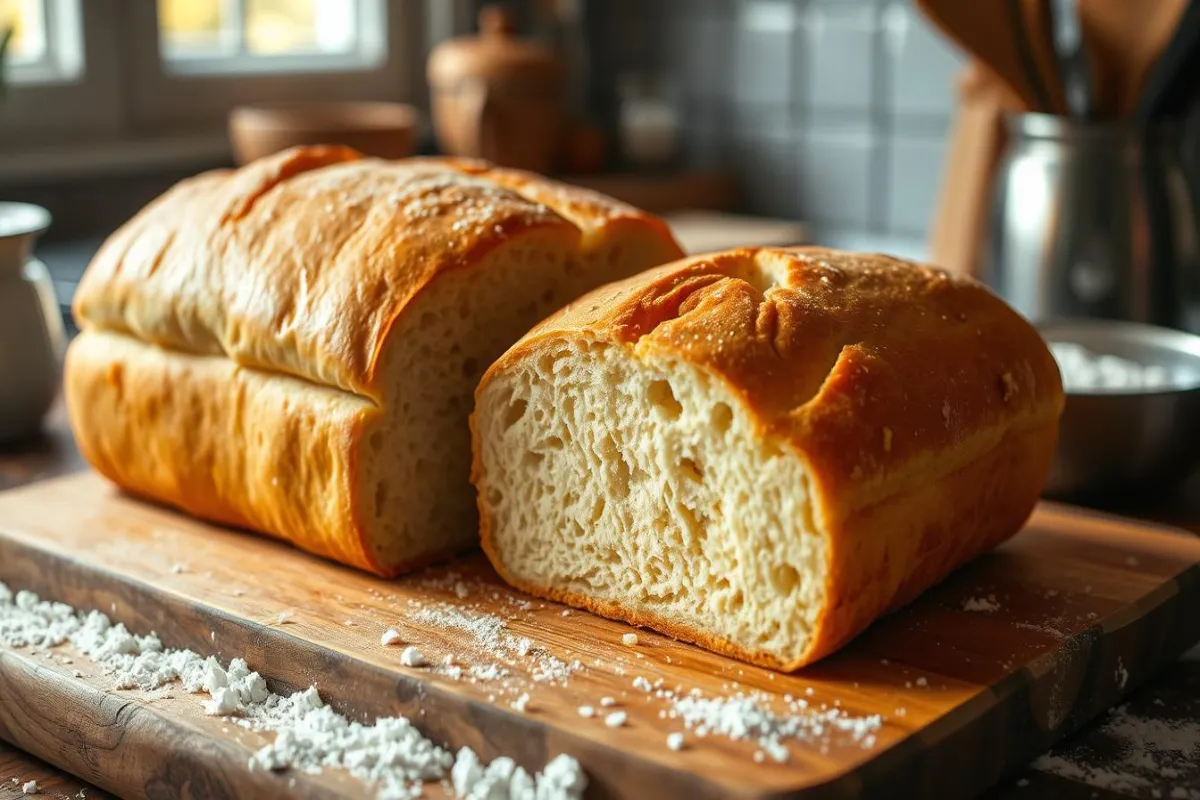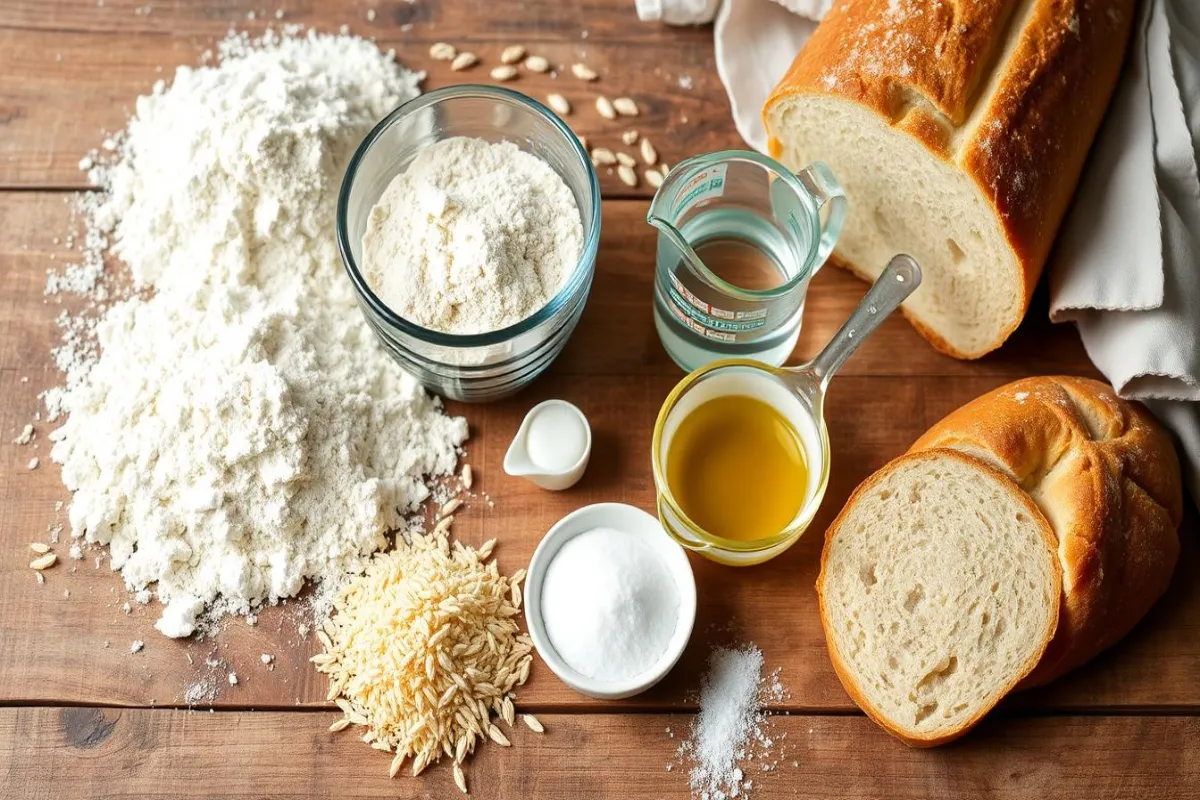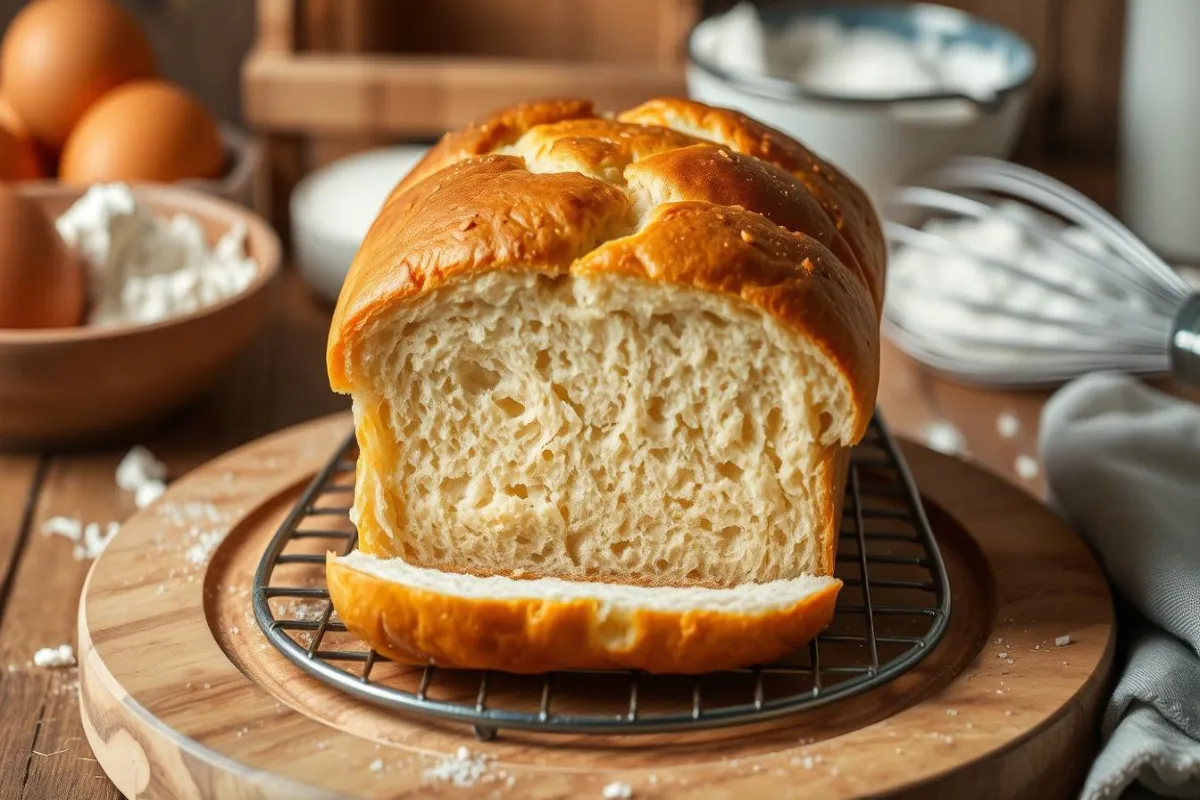Baking your own sandwich bread at home is a rewarding and delicious experience. I’m excited to share with you an easy recipe. It produces soft, fluffy loaves perfect for sandwiches, toast, or fresh from the oven. Whether you prefer classic white bread or a heartier whole wheat version, this guide will help you create artisan-style, no-knead bread.
This bread will fill your kitchen with the irresistible aroma of freshly baked bread. In this article, I’ll cover the essential bread ingredients and demonstrate the proper bread baking techniques. I’ll also provide tips for bread making and baking to ensure your yeast bread recipes turn out perfectly soft sandwich bread every time.
Whether you’re a beginner baker or an experienced home cook, you’ll find the guidance you need. You’ll learn how to make bread dough and bake it to perfection in a loaf pan.
The Joy of Homemade Sandwich Bread
Baking your own bread at home is incredibly rewarding. You get to make something from scratch and enjoy the amazing smell and taste of homemade bread. Making your own soft sandwich bread lets you control the ingredients and flavors. It’s also fun to share a homemade loaf with loved ones.
Why Bake Your Own Bread?
Homemade bread making lets you pick the best ingredients. You can avoid preservatives found in many store-bought artisan bread. Plus, baking at home is calming and connects you to a long-standing tradition.
The Benefits of Fresh, Homemade Bread
- Unmatched flavor and texture: Freshly baked homemade bread tastes better than store-bought.
- Customizable options: You can try different bread making methods and ingredients to find your favorite no-knead bread or soft sandwich bread.
- Healthier ingredients: Homemade bread lets you choose better ingredients, making it a healthier option.
- Satisfaction of DIY: There’s pride in baking your own fresh bread from scratch.

“Baking bread is one of the most satisfying and rewarding experiences a home cook can have.” – Julia Child
Gathering the Essential Ingredients
To start making your own sandwich bread, you need a few basic ingredients. You’ll need bread flour, active dry yeast, sugar, salt, water, and a bit of oil or butter. You can also add whole wheat flour for a healthier, tastier loaf.
Let’s explore the key ingredients and their roles in making bread:
- Bread Flour: This flour gives your bread its chewiness and structure. It has more gluten, which is key for the right texture.
- Active Dry Yeast: Yeast makes the dough rise, making the bread light and airy. It eats the sugars to create carbon dioxide, which makes the bread fluffy.
- Sugar: A bit of sugar adds sweetness and helps the yeast grow. This fuels the dough’s rise.
- Salt: Salt enhances the bread’s flavor and balances the sweetness.
- Water: Water holds the dry ingredients together, allowing the dough to rise.
- Oil or Butter: Adding a bit of fat makes the bread tender and richer.
- Whole Wheat Flour: Using some whole wheat flour makes the bread healthier. It adds fiber, vitamins, and minerals.
With these ingredients, you’re ready to bake a tasty homemade sandwich bread. Next, we’ll learn how to work with the bread dough!

Mastering the Bread Dough
Making the perfect bread dough is key to delicious homemade sandwich bread. From mixing to kneading, each step is important. They help create the right texture and rise for your yeast bread.
Kneading Techniques for Perfect Dough
Kneading the dough is crucial, whether by hand or with a stand mixer. Stretching and folding the dough activates gluten. This makes the bread chewy and gives it structure.
Knead for about 10 minutes. Be careful not to overwork it. Overworking can make the bread tough and dense.
Proofing and Rising: The Key to Fluffy Bread
After kneading, the dough needs to proof and rise. This lets the yeast work its magic. It turns the dense dough into a light, airy loaf.
Cover the dough and let it rise in a warm, draft-free area. It should double in size, which takes about an hour. Punching it down and letting it rise again develops the bread’s structure and flavor.
| Kneading Technique | Time | Result |
|---|---|---|
| Stand Mixer | 5-7 minutes | Smooth, elastic dough |
| Hand Kneading | 10-12 minutes | Slightly more dense, chewier texture |
“Kneading is the key to developing gluten, which gives bread its structure and chewiness. Take the time to knead your dough properly, and you’ll be rewarded with a beautifully risen, light loaf.”
sandwich bread recipe
Making the perfect sandwich bread at home is rewarding. It lets you choose the ingredients and make a fresh loaf. You can pick between classic white or hearty whole wheat bread. This easy recipe will show you how to do it step by step.
To start, you’ll need these ingredients:
- 3 cups (375g) of all-purpose flour or bread flour
- 1 teaspoon of salt
- 1 tablespoon of sugar
- 1 package of active dry yeast (about 2 1/4 teaspoons)
- 1 1/4 cups (295ml) of warm water (between 110-115°F/43-46°C)
- 2 tablespoons of unsalted butter, melted
In a big mixing bowl, mix the flour, salt, sugar, and yeast. Make a well in the middle and add the warm water and melted butter. Use a wooden spoon or your hands to mix until a shaggy dough forms.
Put the dough on a floured surface and knead for 10 minutes. It should be smooth, elastic, and pass the “windowpane test.” If it tears, knead more.
Put the dough in a greased bowl, cover it, and let it rise in a warm, draft-free spot for about 1 hour. It should double in size.
Punch down the dough to get rid of air bubbles. Shape it into a rectangular loaf and put it in a greased 9×5-inch (23x13cm) loaf pan. Cover and let it rise for 30-45 minutes, until it’s about 1 inch above the pan.
Preheat your oven to 350°F (175°C). Bake the bread for 30-35 minutes. It should have a golden crust and an internal temperature of 195°F (91°C). Let it cool in the pan for 10 minutes before cooling it completely on a wire rack.
Enjoy your freshly baked sandwich bread in your favorite recipes. Or, have it as a tasty side to soups and stews.
Baking Your Loaf to Perfection
Baking the perfect loaf of sandwich bread is the final step in making homemade bread. The right temperature and timing help you get a golden-brown crust and a soft inside. Here are the key tips for baking bread to perfection.
Temperature and Timing Tips
To make sure your bread baking goes well, watch the oven temperature and baking time closely. Here are some tips to follow:
- Preheat your oven to 375°F (190°C) for loaf pan baking.
- Bake the bread for 30-35 minutes, or until the crust is a deep golden-brown.
- Use a meat thermometer to check the internal temperature of the bread; it should read between 190°F (88°C) and 205°F (96°C) when fully baked.
- For a crispier crust, brush the top of the bread with a bit of water or milk before baking.
Watching the oven and checking the bread baking temperature and time often is crucial for a perfect loaf every time.
“The smell of fresh-baked bread is one of the most comforting and irresistible aromas in the world.”
By following these easy tips, you’ll enjoy the joy of pulling a beautifully baked bread from your oven. It’s ready to slice and serve.
Variations and Customization
Baking your own bread at home is fun because you can try new things. You can make everything from whole wheat to garlic bread. Let’s look at some tasty bread variations you can make.
Whole Wheat Sandwich Bread
Want a healthier sandwich bread? Use whole wheat flour instead of all-purpose flour. Whole wheat adds a nutty flavor and keeps the bread soft. Just replace up to 50% of the flour with whole wheat flour and adjust the liquid as needed.
Herb and Garlic Bread
Make your sandwich bread smell amazing with herbs and garlic. Mix chopped herbs like rosemary or thyme with minced garlic into the dough. This makes a savory, fragrant bread great for grilled cheese or soups.
Homemade bread is all about trying new things. By mixing up bread variations and customizable bread recipes, you can find your favorite. Homemade bread lets you explore endless possibilities.
Storing and Serving Your Homemade Bread
Keeping your homemade sandwich bread fresh and flavorful is key. The joy of baking your own bread is best when you can enjoy its aroma and texture. Let’s look at the best ways to store and serve your freshly baked loaf.
Storing Homemade Bread
To keep your homemade bread fresh, follow these tips:
- Let the bread cool completely before storing. This stops moisture buildup and keeps the crust crisp.
- Store the bread in a paper or cloth bag at room temperature. Plastic bags can trap moisture and soften the crust.
- For longer storage, refrigerate the bread. But remember, this might change the texture and taste.
- Freeze fresh bread for longer storage. Wrap it tightly in plastic or foil to avoid freezer burn.
Serving Homemade Bread
Now that you know how to store bread, let’s talk about serving it:
- Slice the bread just before serving to keep it fresh.
- Enjoy the bread with your favorite toppings, like butter, jam, or cheese.
- Toast or grill the bread for a crunchy texture and enhanced flavors.
- Use the bread to make tasty sandwiches with your favorite fillings.
By following these tips, your freshly baked bread will stay flavorful and enjoyable. Whether you eat it right away or save it for later, it will be perfect.
Troubleshooting Common Bread Baking Issues
Baking homemade bread can be very rewarding, but it comes with its own set of challenges. As someone who’s been baking bread for a while, I’m here to help. I’ll share some tips to make sure your sandwich bread always turns out right.
One common problem is making bread that’s too dense. This can happen if you knead the dough too much, use too much flour, or don’t let it proof enough. To fix this, knead for a shorter time and check the dough’s consistency. It should be slightly sticky but not too wet. Also, make sure to follow the proofing instructions carefully to let the dough rise fully.
Another issue is underproofed dough, which can make your bread flat and dense. To solve this, be patient and let the dough rise for the right amount of time. Keep an eye on it, and if it hasn’t doubled in size, give it more time before baking.
Finally, overbaked crusts can be a problem. To avoid this, watch the oven temperature and baking time closely. Use an oven thermometer to check the temperature, and cover the loaf with foil if the crust gets too dark too fast.
- Tip: Invest in a reliable oven thermometer to ensure accurate temperature readings and avoid over-baking.
- Pro tip: Mastering the art of bread baking takes time and practice, so don’t be discouraged if you encounter a few setbacks along the way. With these troubleshooting tips, you’ll be baking perfect homemade sandwich bread in no time.
“Baking bread is one of the most meditative practices I know. It forces you to slow down and pay attention.”
Conclusion
Now you can bake delicious, soft, and fluffy bread at home. You can make classic white bread or try whole wheat or flavored bread. Making bread from scratch is rewarding, with better taste, freshness, and control over ingredients.
Bread baking opens up new possibilities. You can enjoy warm bread with soups or use it for amazing sandwiches. Your homemade bread can make any meal special. Start baking and make homemade bread a part of your kitchen.
Keep improving your bread-making skills and try new recipes. Enjoy the joy of eating bread you made yourself. Happy baking and enjoy the delicious results!
FAQ
What are the essential ingredients for homemade sandwich bread?
To make homemade sandwich bread, you need bread flour, active dry yeast, sugar, and salt. Also, add water and a bit of oil or butter. You can use whole wheat flour for a healthier option.
How do I properly knead the bread dough?
Kneading the dough is key for the right texture and rise. I’ll guide you through kneading, with or without a stand mixer. Aim for a smooth, elastic dough that passes the “windowpane test”.
How important is the proofing and rising process for homemade bread?
Proofing and rising are vital for fluffy homemade bread. Yeast needs time to make the dough rise and develop its structure.
What’s the optimal oven temperature and baking time for homemade bread?
For a perfect loaf, preheat your oven to 375°F (190°C). Bake for 25-30 minutes. This ensures a crispy crust and soft inside.
Can I make whole wheat or flavored variations of the sandwich bread recipe?
Yes, you can! Try whole wheat or add herbs and garlic for a twist. I’ll guide you on how to adjust the recipe and baking for these variations.
How should I store my freshly baked homemade bread?
Storing bread right is crucial for freshness. I’ll share tips on keeping your loaf fresh, whether you’re enjoying it now or saving it for later.
What are some common bread baking issues and how can I troubleshoot them?
Baking bread can have its challenges. I’ll help you solve issues like dense bread, underproofed dough, and overbaked crusts. Follow my tips for perfect homemade sandwich bread every time.

